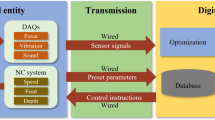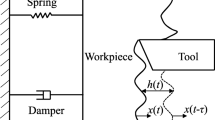Abstract
The ARMAX model-based monitoring method is proposed for chatter detection in thin wall turning operation. ARMAX modelling is deduced to fit the cutting force for the time varying dynamic process caused by the stiffness variation of thin wall workpiece. Residuals closely connected with chatter are extracted and monitored by control charts in real time. Cutting experiments for two different depth of cuts are performed for verification, from which it is found that the ARMAX model-based monitoring process has lower false alarm rate than the typical ARMA modelling. In addition, the model parameters affected by the varying stiffness is also time dependent, so the RELS parameter estimation algorithm is employed. The forgetting factor in the RELS algorithm is optimized through experiments to further reduce the false alarm rate. It is observed that the RELS ARMAX model-based algorithm with forgetting factors between 0.85 and 0.9 has the best monitoring performance with zero false alarms.
Access this chapter
Tax calculation will be finalised at checkout
Purchases are for personal use only
Similar content being viewed by others
References
Tansel, I.N., Wagiman, A., Tziranis, A.: Recognition of chatter with neural networks. Int. J. Mach. Tools Manuf 31(4), 539–552 (1991)
Wu, Y., Du, R.: Feature extraction and assessment using wavelet packets for monitoring of machining processes. Mech. Syst. Signal Process. 10(1), 29–53 (1996)
Govekar, E., et al.: A new method for chatter detection in grinding. CIRP Ann. Manuf. Technol. 51(1), 267–270 (2002)
Tangjitsitcharoen, S., Pongsathornwiwat, N.: Development of chatter detection in milling processes. Int. J. Adv. Manuf. Technol. 65(5–8), 919–927 (2013)
Sun, Y., Zhuang, C., Xiong, Z.: Real-time chatter detection using the weighted wavelet packet entropy. In: IEEE/ASME International Conference on IEEE, pp. 1652–1657 (2014)
Nouri, M., et al.: Real-time tool wear monitoring in milling using a cutting condition independent method. Int. J. Mach. Tools Manuf 89, 1–13 (2015)
Sun, Y., Xiong, Z.: An optimal weighted wavelet packet entropy method with application to real-time chatter detection. IEEE/ASME Trans. Mechatron. 21(4), 2004–2014 (2016)
Fu, Y., et al.: Timely online chatter detection in end milling process. Mech. Syst. Signal Process. 75, 668–688 (2016)
Ravindra, H.V., Srinivasa, Y.G., Krishnamurthy, R.: Acoustic emission for tool condition monitoring in metal cutting. Wear 212(1), 78–84 (1997)
Tansel, I.N., McLaughlin, C.: Detection of tool breakage in milling operations—I. The time series analysis approach. Int. J. Mach. Tools Manuf 33(4), 531–544 (1993)
Altintas, Y.: In-process detection of tool breakages using time series monitoring of cutting forces. Int. J. Mach. Tools Manuf 28(2), 157–172 (1988)
Kumar, S.A., Ravindra, H.V., Srinivasa, Y.G.: In-process tool wear monitoring through time series modelling and pattern recognition. Int. J. Produc. Res. 35(3), 739–751 (1997)
Messaoud, A., Weihs, C., Hering, F.: Detection of chatter vibration in a drilling process using multivariate control charts. Comput. Stat. Data Anal. 52(6), 3208–3219 (2008)
Song, D.Y., et al.: A new approach to cutting state monitoring in end-mill machining. Int. J. Mach. Tools Manuf 45(7–8), 909–921 (2005)
Aghdam, B.H., Vahdati, M., Sadeghi, M.H.: Vibration-based estimation of tool major flank wear in a turning process using ARMA models. Int. J. Adv. Manuf. Technol. 76(9–12), 1631–1642 (2015)
Tlusty, J., Andrews, G.C.: A critical review of sensors for unmanned machining. CIRP Ann. Manuf. Technol. 32(2), 563–572 (1983)
Altintas, Y.: Manufacturing Automation: Metal Cutting Mechanics, Machine Tool Vibrations, and CNC Design, 2nd edn. Cambridge University Press, New York (2012)
Brockwell, P.J., Davis, R.A.: Introduction to Time Series and Forecasting. Springer, New York (2016). https://doi.org/10.1007/b97391
Paleologu, C., Benesty, J., Ciochina, S.: A robust variable forgetting factor recursive least-squares algorithm for system identification. IEEE Signal Process. Lett. 15, 597–600 (2008)
Fung, E.H.K., et al.: Modelling and prediction of machining errors using ARMAX and NARMAX structures. Appl. Math. Modell. 27(8), 611–627 (2003)
Messaoud, A., Weihs, C.: Monitoring a deep hole drilling process by nonlinear time series modeling. J. Sound Vib. 321(3–5), 620–630 (2009)
Author information
Authors and Affiliations
Corresponding author
Editor information
Editors and Affiliations
Rights and permissions
Copyright information
© 2018 Springer Nature Switzerland AG
About this paper
Cite this paper
Liu, Y., Xiong, Z. (2018). Chatter Detection Based on ARMAX Model-Based Monitoring Method in Thin Wall Turning Operation. In: Chen, Z., Mendes, A., Yan, Y., Chen, S. (eds) Intelligent Robotics and Applications. ICIRA 2018. Lecture Notes in Computer Science(), vol 10984. Springer, Cham. https://doi.org/10.1007/978-3-319-97586-3_29
Download citation
DOI: https://doi.org/10.1007/978-3-319-97586-3_29
Published:
Publisher Name: Springer, Cham
Print ISBN: 978-3-319-97585-6
Online ISBN: 978-3-319-97586-3
eBook Packages: Computer ScienceComputer Science (R0)




